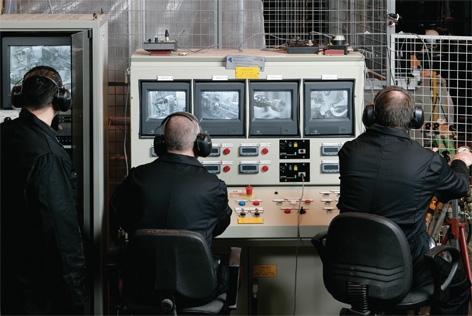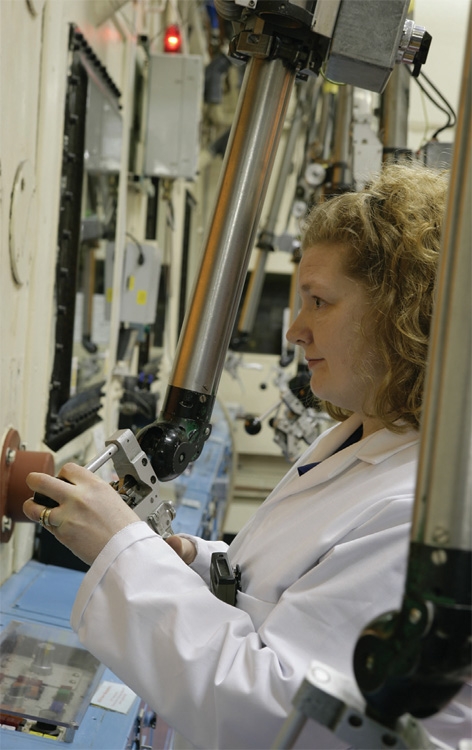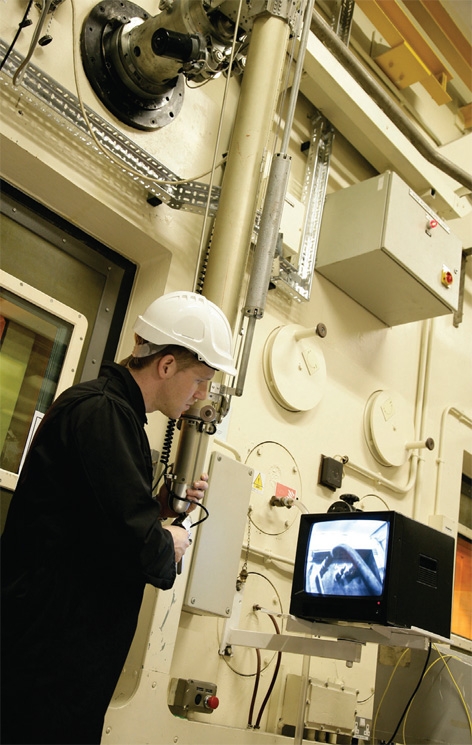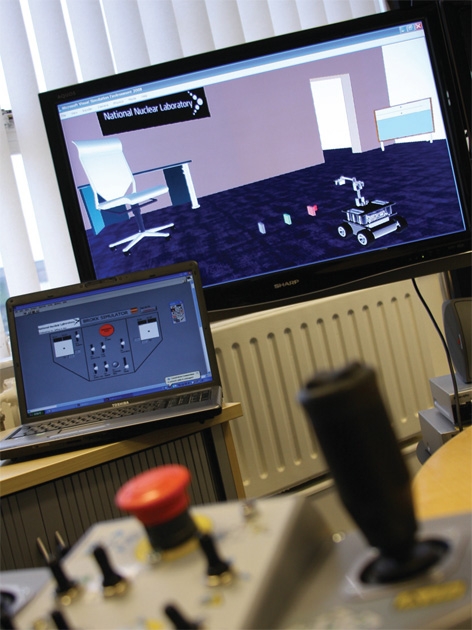Decommissioning essentially starts after fuel rods and other concentrated sources of radiation have been removed from the site. This reduces the amount of residual radiation to less than one per cent of that during operation in the case of a nuclear power station.
In fact, much of the decommissioning process uses well-established demolition techniques. There is of course one major added complication to take into account with nuclear decommissioning: the hazard of radiation release.

With this in mind, there are three main recognised decommissioning strategies currently in use: immediate decontamination and dismantling (DECON); safe storage (SAFESTOR); and entombment (ENTOMB). Since the last is an emergency measure to encase the whole structure in concrete, it can be discounted for the UK.
Under DECON, everything is decontaminated to a level that permits the removal of regulatory control shortly after the shutdown of operations. The advantage is that the site is freed quicker and at least some of the previous workforce can be retrained for decommissioning. However, more waste is produced and workers are exposed to a greater radiation hazard.
Operating a master slave manipulator is a terribly skileld job - it requires a considerable amount of natural talent
Prof. Anthony Banford, NNL
By contrast, SAFESTOR involves placing the facility in a safe condition and waiting until the radioactive materials have decayed to reduced levels. It leads to easier dismantling and reduced quantities of waste and generally lower overall costs.
Government policy in the UK and elsewhere has been to get the job done as quickly as possible, considering both safety and economic considerations. So a combination of DECON and some SAFESTOR is generally deployed.

But the only means of coping with such a large amount of waste quickly while reducing the dose exposure to workers is through the use of robotics.
In a decommissioning context, this has generally meant tele-operation as distinct from full automation, where someone is operating a device - a vehicle or an armature - with a joystick or some other kind of interface.
‘It might be a master-slave manipulator, or you might be deploying a remotely operated vehicle to go to a point, grasp a pipe and cut it and remove it from the system,’ Prof Anthony Banford, technical authority of legacy waste and decommissioning at the Nation Nuclear Laboratory (NNL), told The Engineer.
‘There might be some degree of automation in that - you might be driving the end effector of the robot rather than joint by joint - but broadly speaking the person is doing the interpretation of the environment and then driving the robotic system.’
Tele-operation has the advantage of being quite flexible and versatile and can deal with environmental variability quite well. It is also quite slow and inefficient.
‘In a tele-operated system, you’re entirely reliant on the availability of, and the pressures that are placed on, the individuals that are operating the systems, and that’s very much the situation we’re in. Operating something like a master-slave manipulator is a terribly skilled job - it requires a considerable amount of natural talent for that particular skill. Operators often find themselves doing mental gymnastics,’ Banford said.
Autonomous systems, where they exist in decommissioning, are suited to very specific tasks, and are not really able to take decisions or adapt like a human operator can. Over the past 12 months, the Technology Strategy Board (TSB) has been co-ordinating a number of feasibility studies addressing the question of whether greater degrees of autonomy can be realistically adopted in various aspects of nuclear decommissioning.
‘The thinking behind this was that in other industries there’s been some reasonable advances in technology for autonomous operations - so oil and gas exploration, space, medical and production and manufacture. These things have all moved forward over recent years - and the question we’re trying to address is: “Is there potential for this kind of technology to help make a step-change in performance in decommissioning?”’ Banford said.
There were 20 sponsored projects in all (with around five focusing solely on decommissioning), which received up to 75 per cent funding with the maximum project value being £100,000 - all led by small and medium-sized enterprises (SMEs) with the assistance of several partners.
Notable projects included OC Robotics and TWI with their snake-arm robot technology (currently used in medical surgery) for autonomous laser cutting in confined spaces; Claresys and Mirion Technologies with their endoscopic surveillance solutions for identifying radioactivity in buildings being decommissioned; and the Shadow Robot Company, NNL and RU Robots, which looked more generally at the challenges of shifting from tele-operation to tele-autonomy.
‘Tele-autonomy would be some degree of autonomy on top of the normal operations, so you’d be aiming to almost give the device a mission, so

the device would go away to do a task and would somehow, from sensors, interpret its environment and carry out that activity. For example, a device that went in to cut a pipe would be able to go to a particular point, cut a pipe and recognise the changes in the environment that have resulted,’ Banford explained.
The various project teams were tasked with addressing how existing autonomous technologies could be integrated or adapted for use, with several demonstrator trials being performed.
The group, led by Shadow, concluded that automation has the potential to reduce decommissioning costs by 10-20 per cent over the existing decommissioning plans, as well as allowing more flexible working with reduced risk to workers.
Cross-project research and development would help here, they said, as well as the adoption of a common strategic roadmap across the industry. While they believe that technologies could be brought across from other areas where robotics is used, nuclear-specific development is needed to enable this.
After the presentation of the feasibility studies on 28 March 2012, the TSB announced a follow-on research project - ‘Developing the civil nuclear power supply chain’ - with £15m of funding up for grabs.
NNL, which also develops decommissioning robotics independently as well as with the TSB, will design more technology demonstrators within its non-active test facilities, with the end user involved in that development.
20% The percentage by which automation could reduce decommissioning costs over existing plans
‘In terms of the technology, as opposed to the application, [we are] looking at things such as data acquisition, building up pictures of the environment that you’re about to decommission, bearing in mind most of these are old facilities that were operated for 40 years or longer, where the workforce that designed them are long gone, and they weren’t designed in the 3D CAD [computer-aided design] age,’ Banford said.

He added: ‘One of the greatest assets in decommissioning is knowing your starting point so being able to deploy devices to pull up a picture of the facility - where things are, physically and in geometry, where any high-dose areas are located and picking up the inventory, then visualising that into a form that is really useful to the operator and the designer so they can design their intervention schemes and the devices that they’re going to use.’
Product news
Perfect pens
A six-axis KUKA robot is being used to perform quality-control checks on insulin pens as part of a new automated materials testing system developed by Zwick. The pens, which enable diabetics to self-administer injections, are subject to strict quality assurance controls so product testing needs to deliver reliable and repeatable results.
According to Zwick, using the KUKA robot to load the pens from a magazine and position them in the system avoids the problems often associated with manual test methods. The system then measures various functions such as dose setting and actuation force in a continuous process.
Speedy Spider
Endoline Machinery has launched the Spider palletising robot to the UK packaging market. Thanks to its fast gripper changing system - from vacuum gripper to a clamping gripper - the Spider is suitable for use in a variety of sectors, including food and drink, pharmaceuticals and cosmetics. The Spider is a servo-driven gantry robot built with three or four axes and is able to palletise boxes, crates, buckets, bags or other packed goods from one or multiple lines. Operated by interpolated controls, the heavy-duty linear axes move like spiders with speed and accuracy, enabling the machine to reach high speeds of up to 10 cycles per minute.




Red Bull makes hydrogen fuel cell play with AVL
Formula 1 is an anachronistic anomaly where its only cutting edge is in engine development. The rules prohibit any real innovation and there would be...